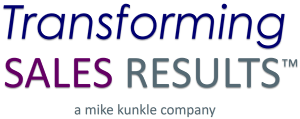How to Develop a Sales Enablement Plan That Delivers Results
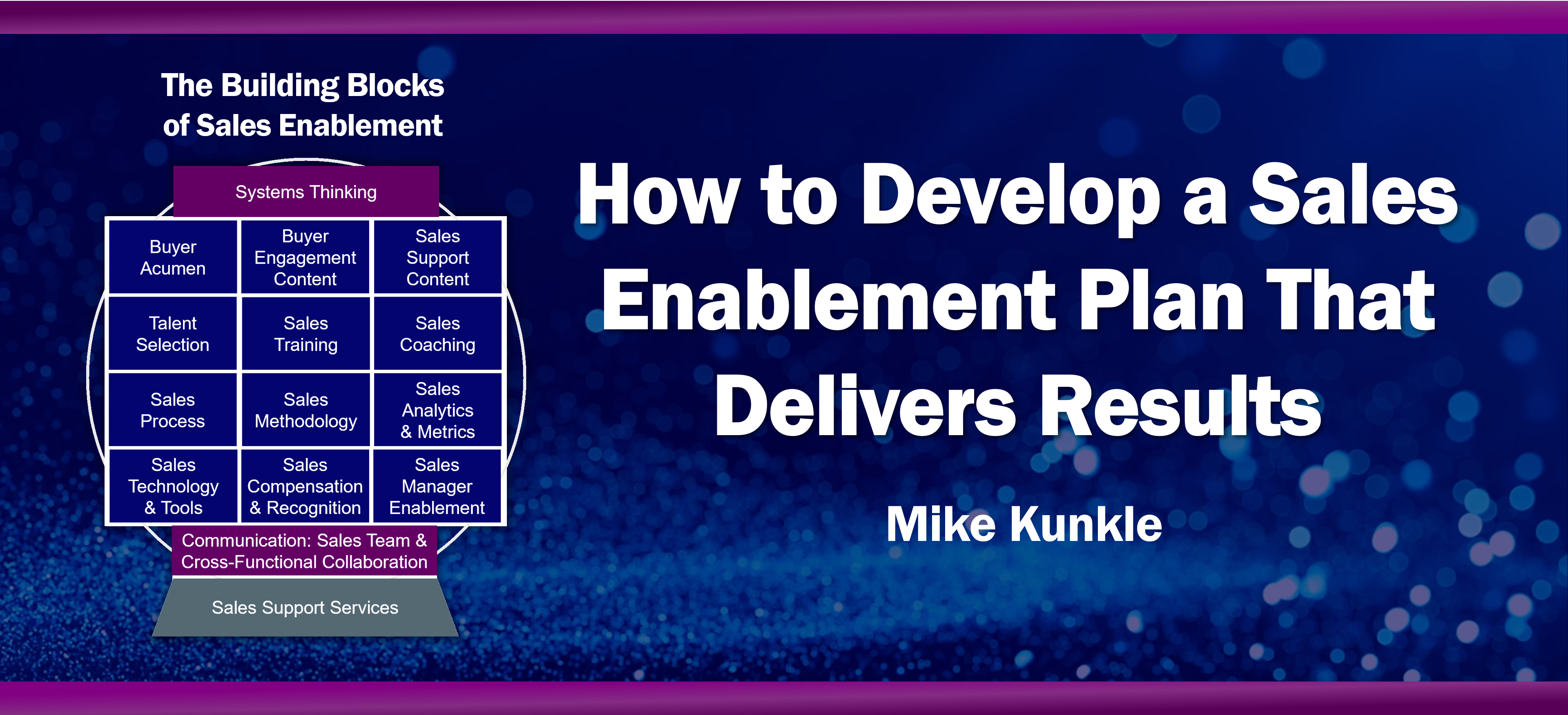
It’s a cruel twist of fate for senior sales and revenue leaders that as the year barrels toward a close with urgency to maximize the remaining time, that strategic and tactical planning for the next year must happen at the same time.
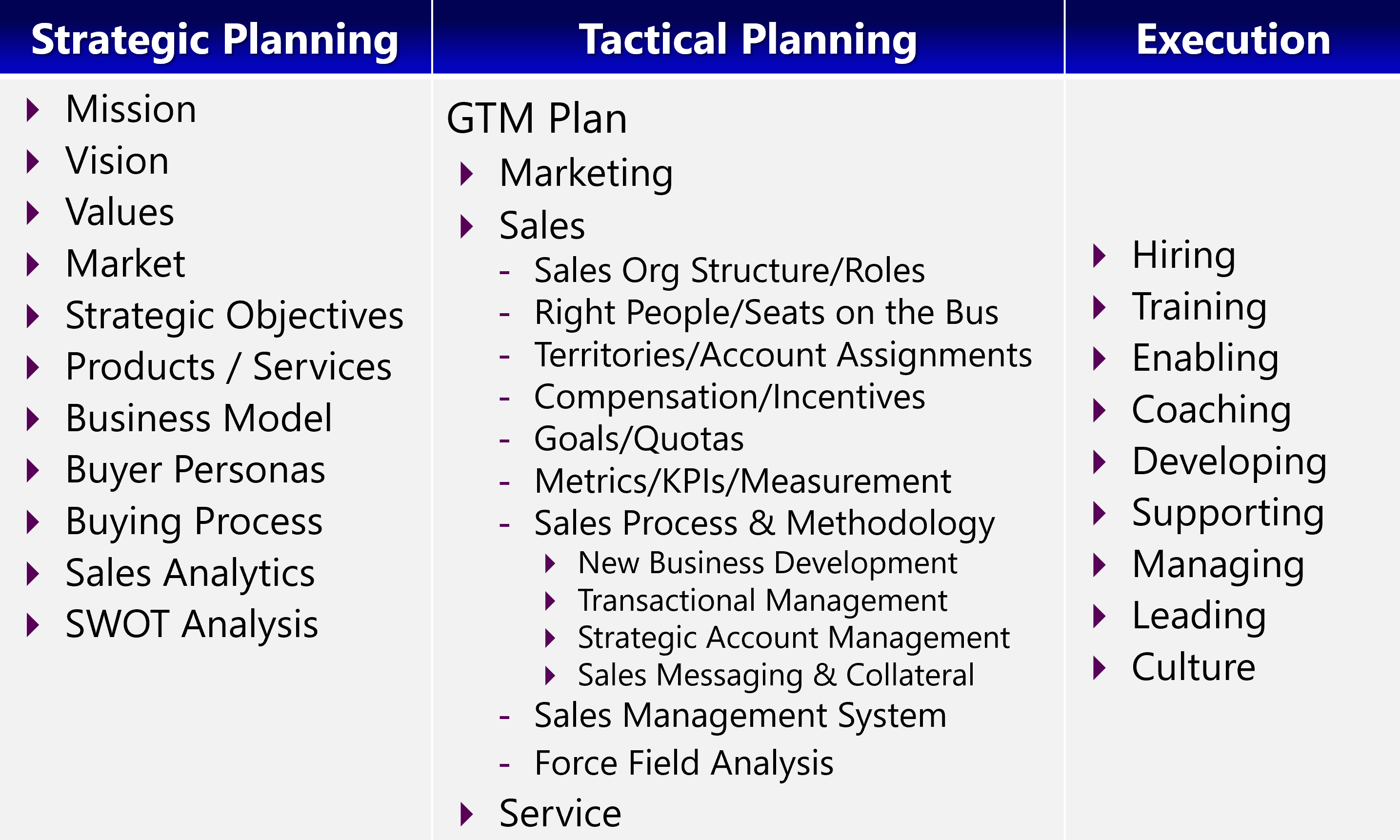 At a minimum, these leaders must tackle quota setting, territory optimization, account assignments, account plans, any compensation plan updates, go-to-market strategy shifts, tactical plans, playbooks, and more. If they’re facing market disruption, they may need to navigate even more of the above chart (with their executive team colleagues) to ensure they survive and thrive through the coming year. (For maximum effectiveness, the things on the left are a dependency for the things to the right of them.)
At a minimum, these leaders must tackle quota setting, territory optimization, account assignments, account plans, any compensation plan updates, go-to-market strategy shifts, tactical plans, playbooks, and more. If they’re facing market disruption, they may need to navigate even more of the above chart (with their executive team colleagues) to ensure they survive and thrive through the coming year. (For maximum effectiveness, the things on the left are a dependency for the things to the right of them.)
When you layer in talent development and the critical shifts thrust upon us by other situational and market forces, such as the evolution toward a more buyer- and customer-centric approach, digital buying journeys, mastering virtual selling, and ensuring the sales team is maximizing productivity and effectiveness, it’s no wonder that Sales Ops/RevOps is experiencing a resurgence and Sales Enablement is growing in importance.
And for sales enablement leaders who are integrated into the sales force they serve, it’s no different. To make an impact that matters to your leadership team, you need a sales enablement plan that will support your organization’s goals and objectives and enable your sales force to reach its highest potential next year.
Five Questions That Will Help You Plan for Impact
- What are the Building Blocks of Sales Enablement?
- How can you use them as a diagnostic tool to identify gaps to close?
- How can you use sales analytics and strategic objectives to prioritize those gaps?
- How can you collaborate cross-functionally with your “charter partners” to foster alignment and validate or refine your plans?
- How can you build a business case to support your plan and get the budget you need to deliver the results your leaders want?
Let’s dig in.
The Building Blocks of Sales Enablement
What are the building blocks of sales enablement?
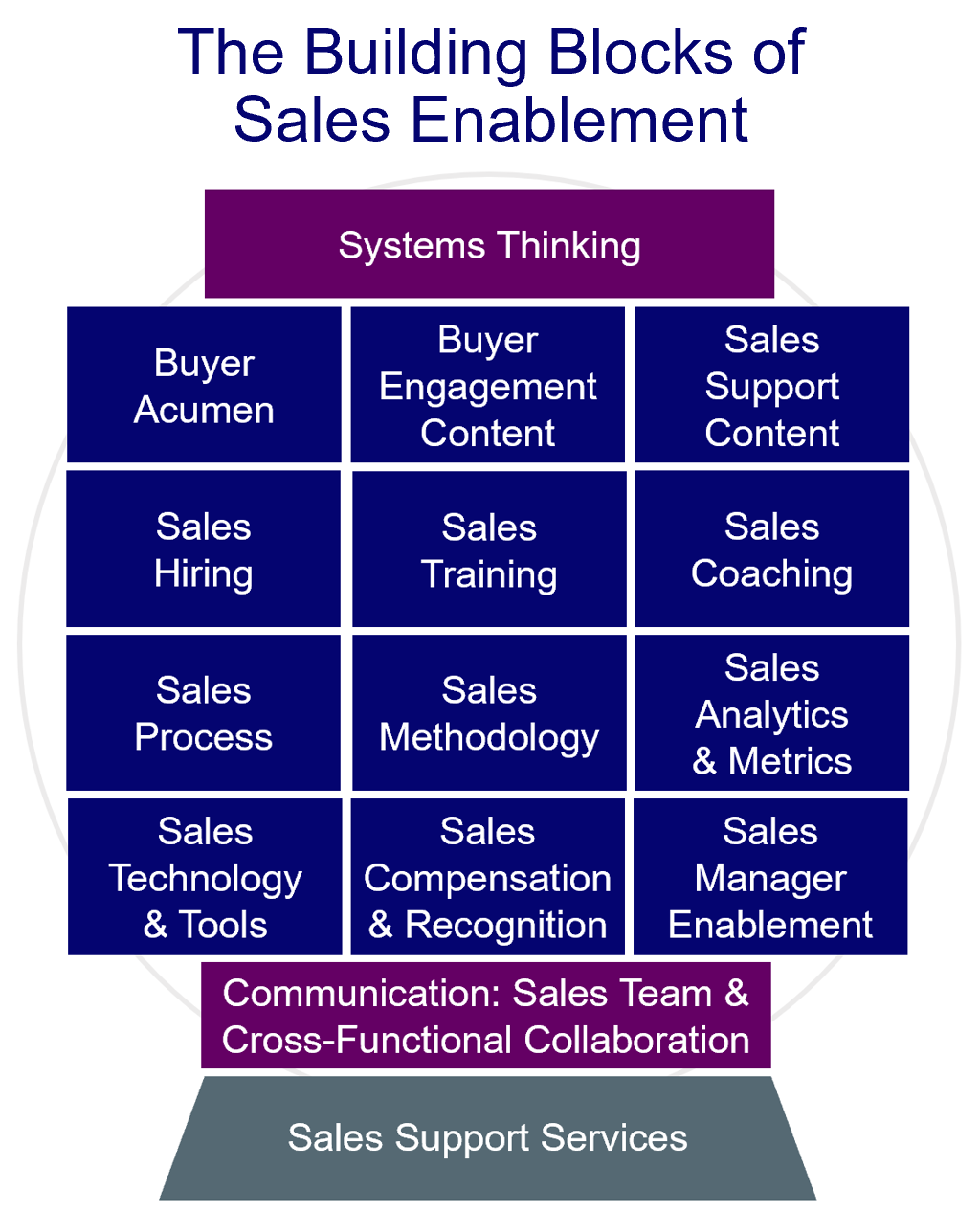 The building blocks are a framework that includes a dozen performance levers you can pull to get better sales results. They’re tied together by systems thinking, cross-functional collaboration, and communication, and in some cases, include sales support services. The blocks are the things you need to do well, and the systems are how you implement the blocks to get repeatable, replicable, predictable results.
The building blocks are a framework that includes a dozen performance levers you can pull to get better sales results. They’re tied together by systems thinking, cross-functional collaboration, and communication, and in some cases, include sales support services. The blocks are the things you need to do well, and the systems are how you implement the blocks to get repeatable, replicable, predictable results.
For example, it all starts with Buyer Acumen – or a deep understanding of your buyers and customers. This is the market you serve and your ICP (ideal customer profile). Who are they, what are their roles and goals, and their COIN-OP, or their Challenges, Opportunities, Impacts, Needs, Outcomes, and Priorities? It’s basically building great personas, with the metrics that matter most (how they’re measured), emotional factors, people they work with internally when buying, their buying process, decision criteria, and more.
Having this information allows you to create buyer engagement content to attract the right buyers to you (based on the problems they have that you solve or the opportunities they face that you can enable) and help them make good decisions at each stage of their journey (culminating in a purchase decision). Then you can build the playbooks and sales support content to help your reps sell to these buyers effectively. Those are the first three building blocks – Buyer Acumen, Buyer Engagement Content, and Sales Support Content.
The next three blocks are Sales Hiring, Sales Training, and Sales Coaching. No surprises here, right? We know these are critical and they blend perfectly. All three of these blocks have specific systems that support them, and ways to implement best practices effectively, that will help you get the best possible results.
Next are Sales Process, Sales Methodology, and Sales Analytics & Metrics. These blocks aren’t always “owned” by sales enablement, but they’re important to get right and have a massive influence on sales performance. Sales process and analytics/metrics are often owned by sales operations or RevOps; methodology varies but is increasingly more often owned by enablement. In either case, sales enablement influences the outcomes and orchestrates progress through effective cross-functional collaboration. Sales process, methodology, and analytics are important building blocks to support high performance.
And the last three core blocks are Sales Technology & Tools, Sales Compensation & Recognition, and Sales Manager Enablement. Manager enablement is critical, too often ignored, and far larger than the block size conveys. It also has an entire system dedicated to it – the Sales Management System.
Cross-functional Collaboration and Communication (with a sales enablement charter for alignment) – both with the sales team and the collaborators – comes next. And last, while it’s not something that’s done everywhere, is Sales Support Services – things like RFP/RFI support, presentation support, research support, or even coaching services. I consider the systems, collaboration/communication, and the support services to be things that support the core blocks, but if you want to consider them building blocks, too, please do. Except for the support services, which not everyone offers, all these elements must be present and working to some degree of effectiveness, to achieve maximum sales performance.
Those are the building blocks. (For more detail, see my book here.)
The Sales Systems
In terms of the systems, there are many possible ones you can build. The four I build most frequently (because I’ve seen them make the most impact), are sales hiring, sales readiness, sales training, and sales management (which includes coaching).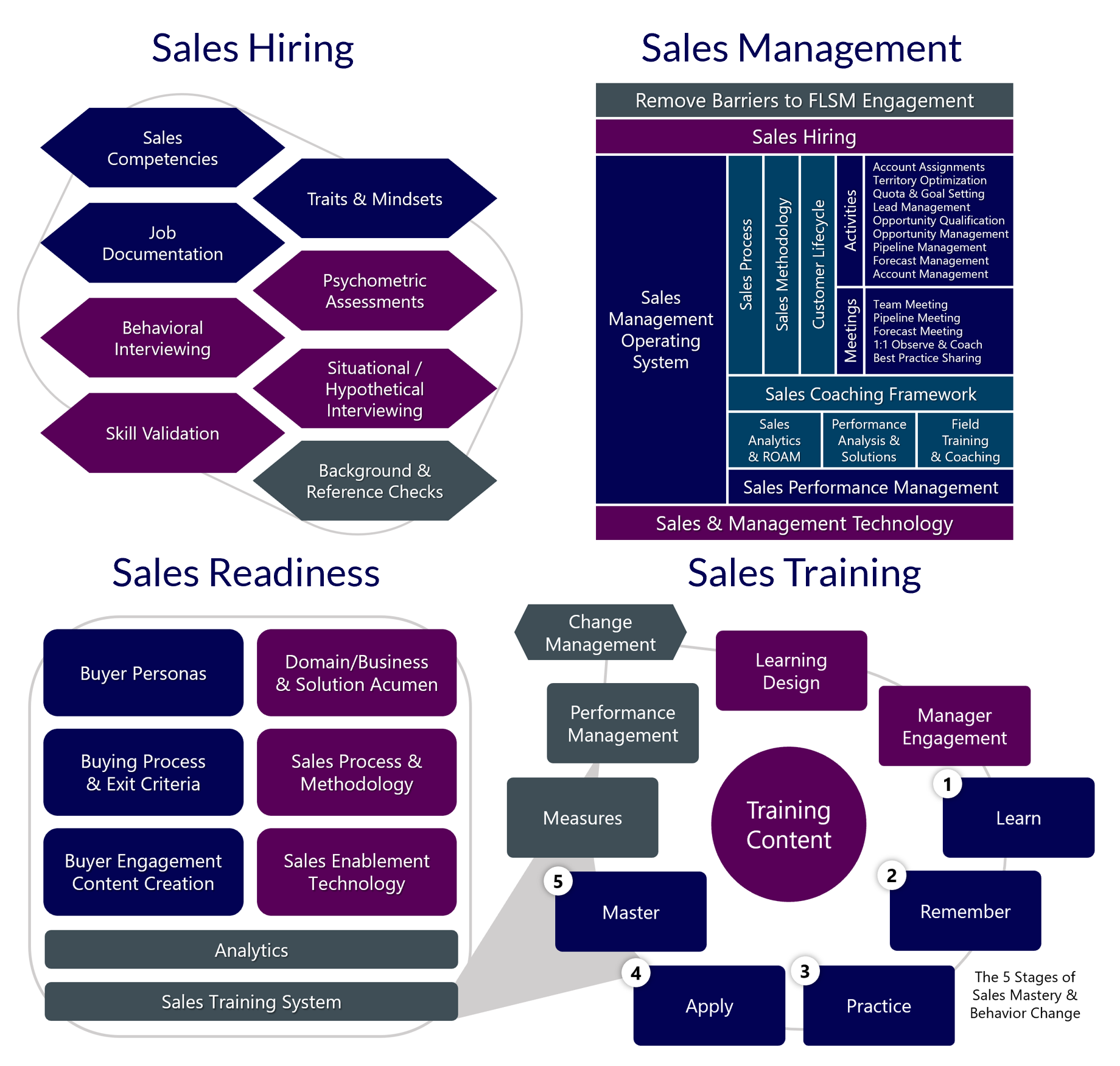 The building blocks are the framework – the “pieces of the puzzle” or performance levers. The systems are how you execute to maximize the blocks, and drive repeatable, replicable, predictable results. Here’s how they integrate.
The building blocks are the framework – the “pieces of the puzzle” or performance levers. The systems are how you execute to maximize the blocks, and drive repeatable, replicable, predictable results. Here’s how they integrate.
| The Building Blocks (By Row) | The Supporting Systems |
| First Row: · Buyer Acumen · Buyer Engagement Content · Sales Support Content |
Sales Readiness System |
| Second Row: · Sales Hiring · Sales Training · Sales Coaching |
Sales Hiring System Sales Training System Sales Training + Sales Management System |
| Third Row: · Sales Process · Sales Methodology · Sales Analytics & Metrics |
Sales Readiness System + Sales Management System |
| Fourth Row: · Sales Technology & Tools · Sales Compensation · Sales Manager Enablement |
Sales Readiness System + Sales Management System |
With that foundation, let’s dig in further to create that plan we talked about.
Use the Blocks as a Diagnostic Tool
Since the goal is to develop a sales enablement plan that will drive results, you should start with a gap analysis. I suggest moving through the blocks, assessing each one, to determine what’s in place, what’s a strength, what’s “good enough for now” (GEFN), and where the biggest gaps are. Then, prioritize to close the gaps, based on what you believe will best support your company’s current strategic objectives and tactical plans. In general, this is a great performance consulting method, to get started. For clarity, while it seems like I’ve just grossly oversimplified gap analysis, I’m not saying to identify the specific solution within in any given block without doing a deeper root cause analysis, but for higher-level planning purposes, you certainly should be able to determine which blocks to prioritize for further analysis and solution design, with a thumbnail gap analysis.
Now, that said, there is one disclaimer: The one exception to the gap analysis rule is Buyer Acumen. If you’re not rock solid there, you need to address that first. You must start with the buyers and your market first, or all the downstream work that you do could be misaligned and a lot less effective. So, if that’s a gap, start with deepening your buyer acumen, and then prioritize the rest of the blocks based on your gap analysis.
Prioritize Further with Sales Analytics and Strategic Objectives
If this wasn’t already part of your gap analysis, it needs to happen here. Use analytics like a medical triage. To keep your patient alive (or your sales force functioning), if there’s an airway blockage or bleeding, you need to address those first, and then worry about the broken arm. If discounting practices are endangering profitability, win rates are steadily plummeting, or customer churn is at an all-time high, and these are related to or will prevent the achievement of your leadership team’s strategic objectives for the [month, quarter, half-year, year], this will help you further prioritize blocks and initiatives.
Collaborate Cross-Functionally
In organizations, working in a vacuum rarely produces the best results.
“If you want to go fast, go alone. If you want to go far, go together.”
~ Proverb, origin unknown
Effective sales enablement practitioners know this. It’s why you start with a sales enablement charter, to get aligned with your cross-functional collaborators on how you are going to support your sales force in supporting your buyers and customers. How can you collaborate cross-functionally with your “charter partners” to foster alignment and validate or refine your plans? To start, you can engage them in the gap analysis above, especially for any blocks where you collaborate or don’t own the work or the output, yourself. Or, if you do it authentically (versus manipulatively with a fait accompli), you can start the gap analysis, document your sense of things, and take it to them for their feedback and fuller perspective. You know the people in your organization, so proceed accordingly. In some cases, with some people, it might help to give them “something to throw darts at” rather than a blank slate or empty whiteboard. With others, they’d possibly feel defensive that you started work “in their area” without them. Use your best judgment.
Regardless of how you start, allow your partners to provide feedback. Facilitate a discussion to get perspectives you may not have considered. Learn what others are planning for the coming year already and avoid duplication of effort. Share your thoughts and work so far, authentically and transparently, and seek alignment on the plan, especially the focus, priorities, and accountabilities (who will do what by when). When others own the work, try to leave the “how” up to them, unless you have considerable expertise in the area, or you believe an approach will risk the outcomes you all need. As an example, if a product marketing manager plans to close a gap in Buyer Acumen by doing persona work, and they only intend to include internal perspectives (rather than speaking with or hiring someone to speak with your buyers and customers or those like them), I would consider that to be a serious flaw that could have downstream negative impacts and hamper your effectiveness. Once again, use your best judgment.
Done well, with good intentions and the teamwork that is behind the old saying, “None of us is as smart as all of us,” you’ll have a vetted, more effective plan in the end. And, you’ll have alignment on initiatives with accountability measures in place.
Create Your Enablement Business Case
So, now that you have done this work, how can you build a business case to support your plan and get the budget you need to deliver the results your leaders want? Not surprisingly, a sales discovery methodology works exceptionally well here. In our Modern Sales Foundations course at SPARXiQ, we call it a Situation Assessment, and it looks like this:
Situation Assessment Framework
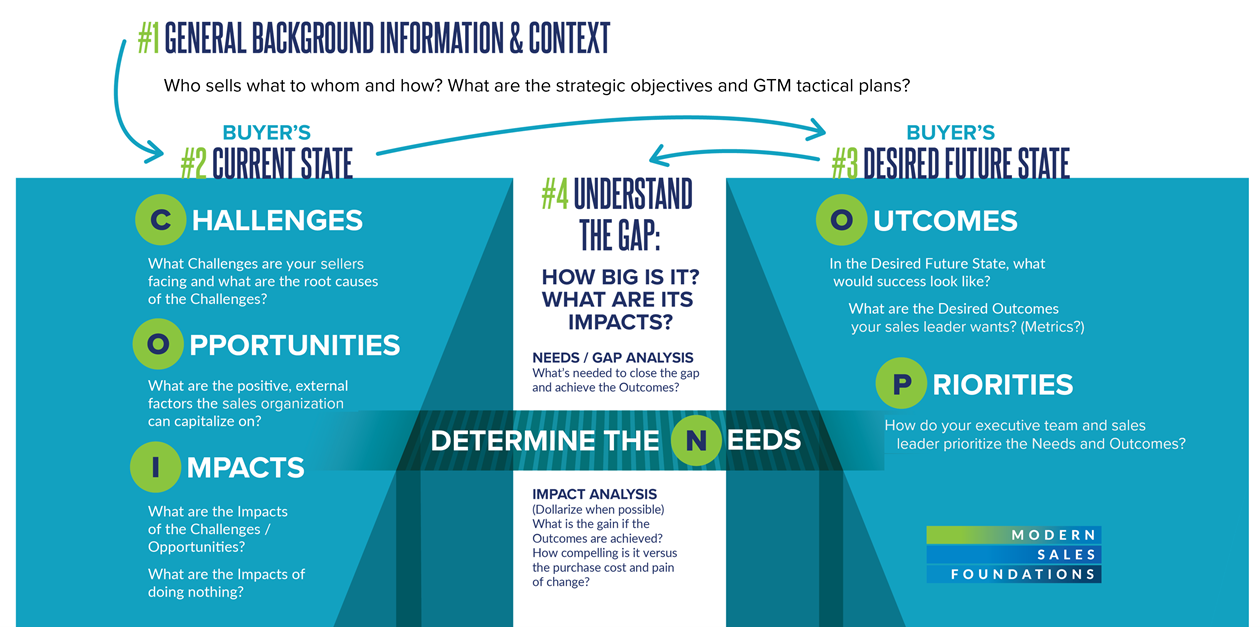 Rather than using this as a buyer-facing discovery approach, you are now using it internally, aimed at your sales force. Using a Current State/Desired Future State framework, you will document COIN-OP and its impacts (COIN-OP = Challenges, Opportunities, Impacts, Needs, Outcomes, and Priorities). The general idea is this:
Rather than using this as a buyer-facing discovery approach, you are now using it internally, aimed at your sales force. Using a Current State/Desired Future State framework, you will document COIN-OP and its impacts (COIN-OP = Challenges, Opportunities, Impacts, Needs, Outcomes, and Priorities). The general idea is this:
- Understand the current state, including the challenges faced, opportunities available, and the impacts of not resolving the challenges or not capitalizing on the opportunities.
- Document the desired future state, including the desired outcomes and the priority of those outcomes. These outcomes should reflect your executive team’s strategic objectives and your sales leader’s goals and objectives for the planning cycle.
- Then you can do a needs or gap analysis to determine what it will take to close the gap and reach the desired future state.
- Lastly, you can conduct an impact analysis, to assess the impact of the gap. What is the dollarized gain if the outcomes are achieved? What risks can be lessened or averted? What cost savings can be documented? Work to dollarize these answers as much as possible.
All the above work enables you to determine how compelling the outcomes are, compared to the cost of the solution(s) and the pain of change. This is the foundation for your sales enablement plan business case.
Creating the Plan to Execute
From here, I believe that most can create a plan to achieve what has been determined the best course of action, but I will close with one piece of advice that has served me very well over the years. Conduct a force field analysis to develop your plan. This approach was adapted from Kurt Lewin’s work in the 1940s, which remains an excellent, logical method for developing plans for change (such as moving from a current state to a desired future state).
Force Field Analysis
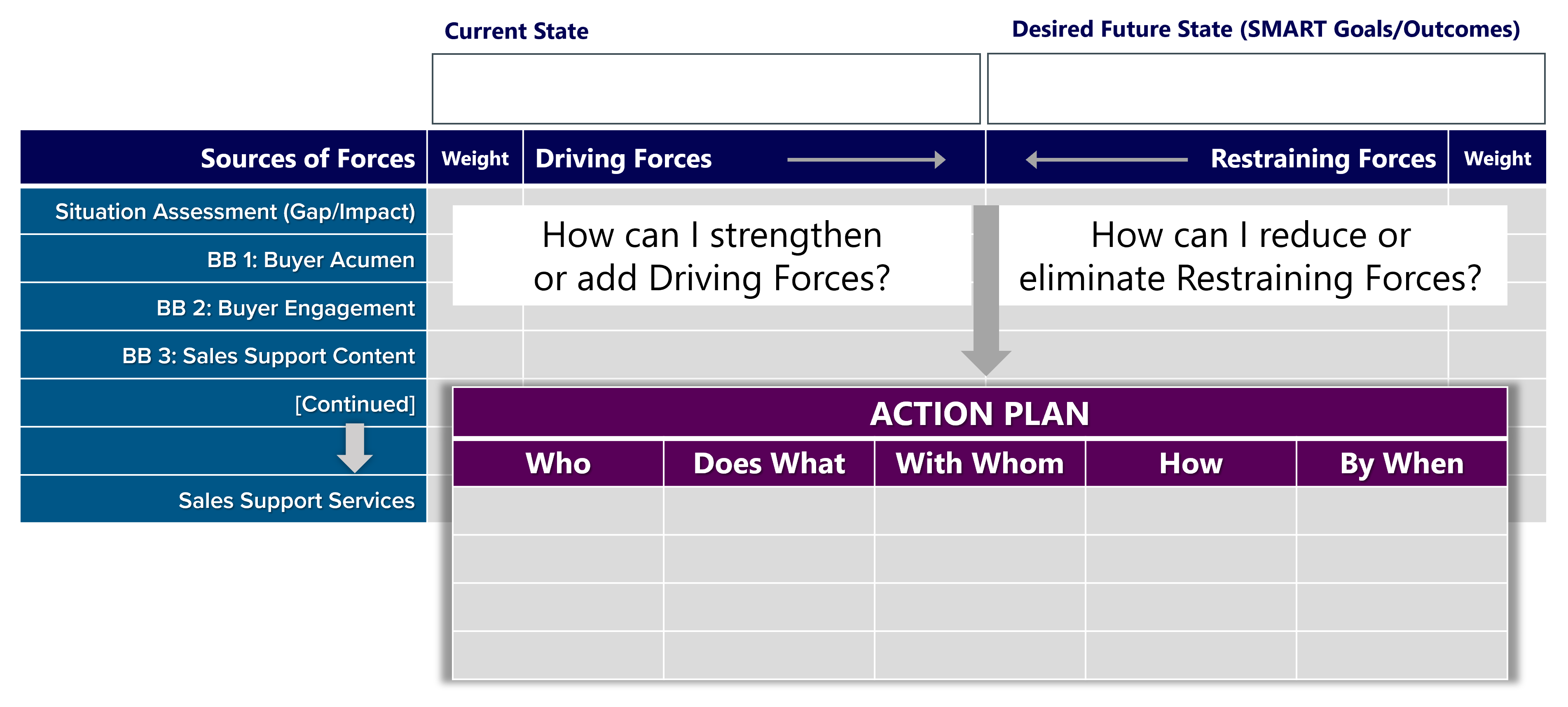 As you’ll see, force field analysis complements the Situation Assessment very well. Here’s how it works.
As you’ll see, force field analysis complements the Situation Assessment very well. Here’s how it works.
- Document the current state (COI from COIN-OP)
- Document the desired future state with prioritized outcomes, now expressed as SMART goals (OP from COIN-OP, but especially the outcomes).
- Consider the forces at play (Sources of Forces), that are present in your current situation, holding you in statis. In this case, I used the Situation Assessment and The Building Blocks. Documenting the Sources of Forces, as I call them, is optional and not part of Lewin’s original method. They can, however, help you consider all the various possible forces and do as complete an analysis as possible. The effectiveness of the force field analysis is directly proportional to the accuracy of the forces and relevance of the actions identified in the next three steps.
- Document and weight the Driving Forces, or anything that is in your favor, nudging you forward toward your desired future state.
- Document and weight the Restraining Forces, or anything that is holding you back, hampering your progress toward your desired future state. Any gaps in information – things you should know but don’t yet – should be considered a Restraining Force,
- To make this work actionable, ask yourself how you can reduce or eliminate the Restraining Forces (first) and how you can strengthen or add Driving Forces. Your answers become your Action Plan. Think of yourself as sitting in a race car, pushing equally on the brake pedal and the accelerator at the same time. The car sits in one place, perhaps rocking on its chassis – but not moving forward. That is the concept of the force field. To achieve the fastest forward motion, take your foot off the brake first, then you can accelerate even faster.
Closing Thoughts
This is not the only planning method we can use in sales enablement. It is, however, an effective one, and it’s been proven effective over many years of use, long before the phrase “sales enablement” came into vogue. Give it a try and write to let me know how it works for you – I’d enjoy hearing.
Mike Kunkle is a recognized expert on sales training, sales effectiveness, and sales enablement. He’s spent over 26 years helping companies drive dramatic revenue growth through best-in-class training strategies and proven-effective sales transformation systems – and he’s delivered impressive results for both employers and clients. Mike is the founder of Transforming Sales Results, LLC and works as the Vice President of Sales Effectiveness Services for SPARXiQ, where he designs sales training, delivers workshops, and helps clients improve sales results through a variety of sales effectiveness services. Mike collaborated with Doug Wyatt to develop SPARXiQ’s Modern Sales Foundations™ curriculum and also authored the SPARXiQ’s Sales Coaching Excellence™ course. His book, The Building Blocks of Sales Enablement, is available on Amazon.
